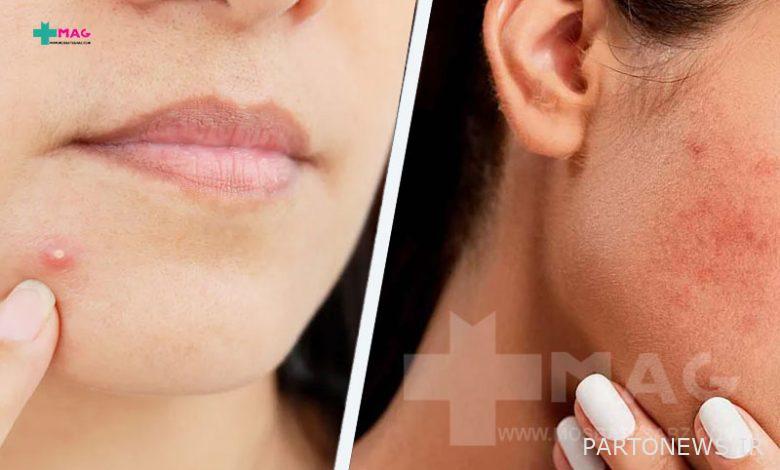The difference between acne and pimples in terms of causes and symptoms

Many of us equate acne and pimples and generally assign any small red round bump on our skin to acne. But you should know that these two are different from each other. Stay with us in the rest of this article to know the difference between acne and pimples.
What is a boil?
When a teenager reaches the age of puberty, his skin starts to thicken and the oil glands are secreted in the skin more than before. Skin oil is necessary to maintain skin moisture and health, but sometimes it can be mixed with pollution and waste materials. When the pores of the skin, which are blocked with oil and pollution, become infected, bumps called pimples appear, which are also caused by the invasion of bacteria. By buying anti-acne cream, you can go to the battle of facial acne.
What is acne?
The scientific name of acne is acne vulgaris. Acne occurs when multiple pimples form on the skin. A boil is usually a single infected bump; While acne refers to the presence of several pus-filled pimples spread over a part of the skin. If you have frequent breakouts, you may be suffering from acne. Fortunately, there are many effective acne treatments that you can use.
The difference between acne and pimples
We mentioned one of the differences between pimples and acne in the previous section. A pimple is usually just one number, but acne refers to multiple pus-filled bumps. On the other hand, it can be said that acne is a disease and acne is one of its symptoms. Acne is a condition that affects the hair follicles and sebaceous glands of the skin. Skin pores are connected to glands that produce an oily substance called sebum. The glands and pores are connected by a duct called a follicle, which contains fine hairs that grow to the surface of the skin.
When sebum and dead skin cells combine, they form a plug in the follicle where the bacteria in it causes inflammation and causes red acne breakouts. To get rid of pimples and acne, it is sometimes necessary to use skin care products such as facial peels.
Pimple is usually seen only on the face and often does not require special treatment. Acne can be treated with a few simple lifestyle changes. But acne is often seen as multiple bumps on the surface of the skin that do not go away easily. Therefore, they need more serious treatment.
The cause of pimples and acne
A difference between acne and pimples can be seen in their cause:
- A wide range of factors can lead to acne. For example: hormonal imbalance, excess sebum, genetics, diet, environmental pollution, etc. Acne occurs when the pores of the skin become blocked with fat, ingrown hair, or other impurities. Bacteria may also play a role in clogging the pores that lead to pimples, but they often don’t cause much inflammation.
- Acne can also occur for all the reasons that pimples can happen. But there are some factors that are strongly associated with the development of acne, which is a long-term skin disease. The transformation of pimples into acne is seen in people who have excessive secretion of sebum in their skin. Excessive secretion of sebum increases bacteria and aggravates inflammation. Hormonal imbalance and genetic factors are also very effective in being prone to acne.
The difference between the symptoms of pimples and acne
While the pimple itself can be a sign of acne, the symptoms of the two are still different:
Acne symptoms
The key symptom of a boil is a shallow bump with a white and black head that has little inflammation. The pimple may even be seen as a spot due to a small bump. The pimple has minimal swelling, redness and tenderness. If acne symptoms are more severe than these, it is probably acne and not acne.
Acne symptoms
When a large number of pimples and inflamed lesions are seen on a large surface of the skin of the face, back or neck, they are called acne, and the person has acne-prone skin. Acne lesions are more prominent than pimples and can exist deep in the epidermis and cause a lot of redness and inflammation. Acne is usually permanent and occurs repeatedly. While the pimple may be fixed after some time and will not reoccur.
Related posts
Treat acne
We explained the difference between acne and pimples. If you sometimes only get a few pimples and get rid of them very soon, the treatment is not so difficult. Sometimes, with a few simple lifestyle changes to deal with oily skin, acne can be removed. Pay attention to the following points:
- Wash your sheets every week.
- As soon as you get home from the gym, take off your gym clothes.
- Be sure to take a shower after exercising.
- Avoid fatty foods in your diet and minimize the consumption of processed foods.
- Minimize the consumption of sugar and all sugary foods and drinks.
- Eat a balanced and nutritious diet.
- Try to drink more water.
- Increase your exercise.

Acne treatment
Acne treatment is usually not easy. Acne occurs as a result of more complex processes than pimples, and as a result, it is more difficult to treat and requires a longer period of time:
- First, consult a dermatologist.
- With the help of a doctor, consider a skin routine for yourself. In this skin routine, you must use the right detergent, hydrate the skin, and use sunscreen regularly. If prescribed by the doctor, the use of peeling and anti-acne should be included in the skin routine.
- It is better to do an allergy test.
- Contraceptive pills and hormonal drugs must be used under the supervision of a doctor.
Even if your acne is not severe, still pay attention to the above and don’t forget the skin routine suitable for acne-prone skin.
How to get rid of hormonal pimples?
Hormonal acne, also known as adult acne, affects adults between the ages of 20 and 50. This type of acne can be seen on the face, shoulders, back, and chest, and its forms can be blackheads, whiteheads, or cysts. Excess sebum in sebaceous glands has a great effect on hormonal acne. There are different treatment options based on the severity of acne:
- For blackheads and whiteheads, tretinoin topical cream
- To treat inflammatory acne: topical retinoid, topical antibiotics or benzoyl peroxide
- Moderate to severe acne: antibiotics or isotretinoin (retinoid).
- Cystic acne: steroid injection (Triamcinolone intralesional)
The cause of forehead acne in girls
The first pimples and acne usually show themselves for the first time during puberty. But acne and pimples can be seen at any age and even among children. There are different types of acne that affect babies and children. Acne occurs when skin pores become clogged with dead skin cells and sebum. Bacteria that are normally on the skin can also enter blocked pores and cause infection and inflammation. This can happen at any age. But if your little one is breaking out too much, follow up with a dermatologist to find out the cause.
The cause of sudden pimples on the face
The sudden occurrence of acne has several reasons, the most important of which are:
- Hormonal changes or hormone imbalance
- An unhealthy diet includes a lot of fried and unhealthy foods
- Release of cortisol hormones due to high stress
- Excessive production of sebum in the skin
Of course, other factors can also be involved.
final word
We explained the difference between acne and pimples in this article. Pimples may go away permanently with a few simple lifestyle changes, but acne requires more serious treatments. If you suffer from acne, you need a doctor’s advice. First, the cause must be determined and then, considering the cause, treatment options will be presented to you.
Please rate this article
[مجموع: ۲ میانگین: ۳]


